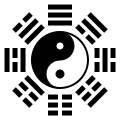Four heavenly ministers
| Part of a series on |
| Taoism |
|---|
 |
The Four Heavenly Ministers (Chinese: 四御; pinyin: Sì yù), also translated as the Four Sovereigns, are four of the highest sky deities of Daoism and subordinate only to The Great Jade Emperor (Chinese: 玉皇上帝; pinyin: Yù huáng shàngdì). They assist the Jade Emperor in administering all phenomenon of the universe.[1][2][full citation needed] The Four Heavenly Ministers (四御 Si Yu), are four deputies assisting the Heavenly Jade Emperor in governing the heaven and earth. They are highly revered in Taoism and positioned just after the Heavenly Jade Emperor.
Four Sovereigns
[edit]The Four Heavenly Ministers are:[3][full citation needed]
- the Great Emperor of the Southern Polar of Longevity[a]
- the Great Emperor of the North Star (Polaris) in the Purple Forbidden enclosure at the center of Heaven (Tian)[b]
- the Great Heavenly Emperor of the Highest Palace of the Curved Array (Little Dipper)[c]
- the Empress of the Earth[d] (Houtu)
The Great Emperor of the Southern Polar of Longevity (南极长生大帝 Nan Ji Chang Sheng Da Di) is in charge of all spirits. He oversees the destiny and fate of humanity, commands over the various thunder spirits and bestow blessings and guidance to all sentient beings. The Great Emperor of the North Star assists the Jade Emperor in managing the sun, the moon, stars, and the climate of the four seasons. The Great Emperor of the Curved Array/Little Dipper oversees all matters in heaven, earth, and the human world. The Empress of the Earth is in charge of fertility, land, rivers, and mountains.[4] The four heavenly ministers are often worshiped in Daoist temples.
Six Sovereigns
[edit]In some later Daoist accounts, this group is extended to six. The Six Heavenly Ministers (Chinese: 六御; pinyin: liù yù) include, in addition to the prior four:[5][6]
- the King Father of the East,[e] also called the Sovereign of the Eastern Florescence[f]
- the Queen Mother of the West,[g] also called the Primordial Lady Golden Mother[h]
Other accounts instead add:
- the Old Man of the South Pole[i]
- the Heavenly Lord of Supreme Oneness and Salvation from Misery,[j] also called the East Pole Emperor of Blue Essence[k]
See also
[edit]Notes
[edit]- ^ Chinese: 南极长生大帝; pinyin: Nánjí chángshēng dàdì.
- ^ Chinese: 中天紫微北極太皇大帝; pinyin: zhōngtiān zǐwēi běijí tàihuáng dàdì.
- ^ Chinese: 勾陈上宫天皇大帝; pinyin: gōuchén shànggōng tiānhuáng dàdì.
- ^ Chinese: 后土皇地祇; pinyin: hòutǔ huáng dìqí.
- ^ Chinese: 東王公; pinyin: dōngwánggōng.
- ^ Chinese: 東華帝君; pinyin: dōnghuá dìjūn.
- ^ Chinese: 西王母; pinyin: xīwángmǔ.
- ^ Chinese: 金母元君; pinyin: jīnmǔ yuánjūn.
- ^ Chinese: 南極長生大帝; pinyin: nánjí chángshēng dàdì.
- ^ Chinese: 太乙救苦天尊; pinyin: tàiyǐ jiùkǔ tiānzūn.
- ^ Chinese: 東極青華大帝; pinyin: dōngjí qīnghuá dàdì.
References
[edit]- ^ Richard Wolff (2007). The Popular Encyclopedia of World Religions. Harvest House Publishers. p. 121. ISBN 978-0-7369-2007-0.
- ^ 《道法會元卷之三》
- ^ 《三教源流搜神大全》
- ^ (in Chinese) – via Wikisource.
- ^ Gesterkamp, L. (5 March 2008). The Heavenly Court: a study on the Iconopraxis of Daoist Temple Painting (Thesis). Leiden University. p. 54. hdl:1887/12632.
- ^ Geng, Jipeng (2008), 金元全真道神仙體系中"六御"身份考 (in Chinese) – via China National Knowledge Infrastructure
External links
[edit]- 道教文化资料库
- 玉皇大帝
- 道法会元卷之三 Archived 2017-09-11 at the Wayback Machine
- 星座探奇
- 神祇列傳-紫微大帝 Archived 2017-08-20 at the Wayback Machine
- 道教之音
- 地母
- 后土皇地祇-地母元君


